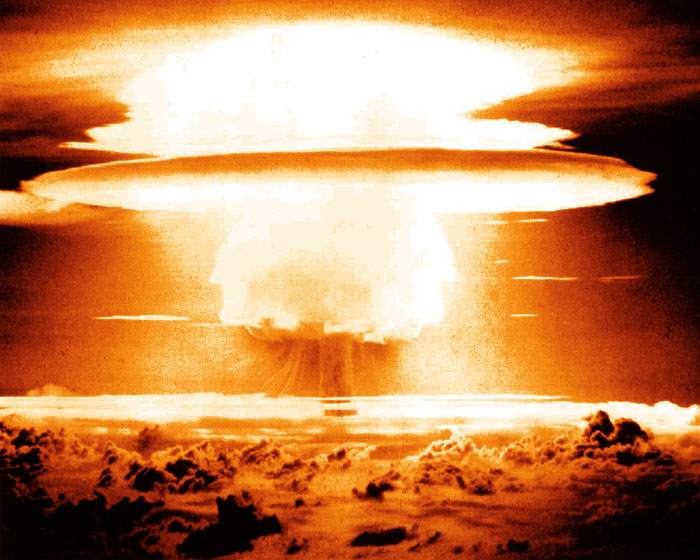Alex Hollings

In recent months, Russian officials have made a number of veiled (and less-than-veiled) nuclear threats that may have left some wondering, what exactly is the difference between an atomic bomb and a modern thermonuclear weapon like those carried by Russia’s ICBMs?
At a very practical level, the most important difference is in their destructive capacity. While atomic bombs are capable of delivering huge amounts of destruction, they actually pale in comparison to the firepower found inside thermonuclear weapons — which are also commonly referred to as hydrogen bombs.
Atomic bombs are the precursors to thermonuclear weapons
Atomic bombs are the original nuclear weapons — first developed by the United States with allied support during World War II within a program known as the Manhattan Project. Atomic bombs, sometimes referred to as atom bombs, leverage a physical process known as nuclear fission to release huge amounts of destructive energy.
In its simplest terms, nuclear fission is the process of splitting one larger atom into two or more smaller ones. In most atomic bombs, this is accomplished by having a neutron strike the nucleus of either a uranium-235 or plutonium-239 isotope. When split, these isotopes release a huge amount of thermal energy (heat) and gamma radiation. In some weapons, the split also releases two or more neutrons which then strike other isotopes, splitting them and creating a chain of fission reactions until all of the fissionable material is expended.
This unchecked chain of fission reactions causes the huge explosion we’re familiar with from atomic test footage.
The atomic bomb dropped on Hiroshima in 1945 had an explosive yield of 15 kilotons or 15,000 tonnes of dynamite. As incredible as that is, it’s practically minuscule compared to some of the massive thermonuclear weapons in service today. Russia’s latest ICBM, the RS-28 Sarmat II, is said to have an explosive yield of 50 megatons.
Fifty megatons are the equivalent of 50,000 kilotons, or 50,000,000 tonnes of TNT.
That means Russia’s newest ICBM has approximately 3,300 times the destructive power of the bomb dropped on Hiroshima.
Thermonuclear weapons leverage fusion and fission to increase destructive capacity
 Castle Bravo hydrogen bomb test (D.O.D. Photo)
Castle Bravo hydrogen bomb test (D.O.D. Photo)Thermonuclear (or hydrogen) bombs also leverage the fission process of splitting the atom to release huge amounts of energy and radiation, but that fission process is aided (or exacerbated) by another physical process known as fusion.
While fission is the act of splitting one larger atom into two or more smaller ones, fusion is the physical process of combining two or more smaller atoms into a single larger one.
It’s not uncommon to see thermonuclear or hydrogen weapons characterized as using fusion to offer greater destructive power than fission-based atomic bombs. While this is technically true, fusion isn’t actually what creates the big boom, so much as it serves as a means to amplify fission’s ability to do so.
In a thermonuclear bomb, detonation begins with a conventional explosion from the weapon’s primary stage. The explosion reaches the weapon’s fissionable uranium and sparks a fission chain reaction just like in an atomic bomb. This atomic detonation is reflected internally and channeled by a uranium chamber into a second stage filled with lithium-6 deuteride.
By channeling the destructive power of an atom bomb into the thermonuclear weapon’s second stage, that lithium-6 deuteride is exposed to heat in the millions of degrees and a huge amount of pressure — enough to begin the fusion process. The energy released by fusion then blows out the second-stage uranium container, and that’s when things get really scary.
As the neutrons released by fusion impact the uranium container to blow it apart, they split more uranium atoms, creating multiple runaway fission detonations that account for the majority of the thermonuclear weapon’s destructive yield.
So, a hydrogen or thermonuclear bomb starts with a conventional detonation that creates fission. That fission power is funneled into a uranium chamber to create fusion, which explodes and creates multiple new fission reactions.
America’s larger thermonuclear warheads like the W87 carried by Minuteman III ICBMs offer an explosive yield of 475 kilotons, or just better than 31 times the destructive power of the Hiroshima bomb.
Okay, then what is a neutron bomb?
 The mushroom cloud from Upshot-Knothole Grable, with the cannon it was fired from in the foreground. (Wikimedia Commons)
The mushroom cloud from Upshot-Knothole Grable, with the cannon it was fired from in the foreground. (Wikimedia Commons)Depending on your perspective, a neutron bomb may seem like the least humane of all nuclear weapons. Neutron bombs are sometimes called “enhanced radiation weapons,” because the function of these weapons is less about explosive power and more about releasing toxic levels of radiation.
Technically speaking, a neutron bomb is a lot like a small thermonuclear weapon, but without the uranium enclosure for the second stage. As a result, the conventional detonation prompts a fission reaction that’s funneled into the second stage full of deuterium-tritium. Without the uranium enclosure to impact, the fusion process does not prompt subsequent fission reactions.
No comments:
Post a Comment